Environmental Justice in the Green Transition of Rural Post-Industrial Waterfronts: A Villagers’ Perspective—A Case Study of the Waterfront Area in Jiangsu Province, China
Abstract
1. Introduction
- 1.
- Which types of landscape characteristics are more likely to elicit recognition justice from villagers?
- 2.
- To what extent are villagers able to participate effectively in landscape projects, and how does their participation influence their recognition of the landscape?
- 3.
- Are the landscapes recognized by villagers equitably distributed in space? Furthermore, does the spatial distribution of these landscapes shape villagers’ overall recognition of environmental justice?
2. Materials and Methods
2.1. Study Site and Framework
2.2. Photograph Collection and Quantification of Landscape Characteristics
2.3. Questionnaire Survey and Semi-Structured Interviews
- (1)
- Socio-demographic background (Q1–Q4). Basic information regarding villagers’ social and demographic characteristics was recorded.
- (2)
- Paired comparison preference elicitation (Q6–Q16). Each respondent was presented with 10 randomly generated pairs of photographs drawn from the set of 48 images. For each pair, villagers were asked to select the photograph they “recognized” more strongly—that is, the one they considered more appropriate for local use and more personally preferable. The photographs were displayed electronically on an iPad by the interviewer, and respondents made their choices directly. The questionnaire was implemented using the Wenjuanxing platform, which ensured equal probabilities for all images to be sampled. Random sampling of pairs, rather than exhausting all possible comparisons, was adopted to mitigate respondent fatigue and attentional decline. Pre-survey tests indicated that 10 pairs represented an optimal balance between robustness and respondent tolerance.
- (3)
- Project participation (Q17–Q21). This section examined villagers’ involvement in the project, with Q20 and Q21 designed as open-ended interview questions.
- (4)
- Overall project evaluation. Finally, respondents were asked to provide an overall evaluation of the project, indicating whether, from their perspective, the project was acceptable and recognized as beneficial for the community (Table 3).
2.4. Discrete Choice Modeling Framework
2.5. Spatial Analysis
3. Results
3.1. Questionnaire Response and Descriptive Statistics
3.2. Discrete Choice Analysis
- (1)
- The interaction between industrial-memory landscape and gender was significant (γ = 0.46, p = 0.018), indicating that male respondents were more likely to select photographs with a higher proportion of heritage landscape.
- (2)
- The interaction between industrial heritage and work history was significant (γ = 0.24, p = 0.020), showing that villagers who had previously worked in the original factories were more likely to select photographs with higher proportions of industrial heritage.
- (3)
- The interaction between water bodies (%) and years of residence in the village was significant (γ = 0.42, p = 0.028), suggesting that villagers who had lived longer in the village were more likely to select photographs with higher proportions of water characteristics.
- (4)
- The interaction between total hardscape (%) and years of residence in the village was significant (γ = 3.37, p = 0.035), indicating that long-term residents were more likely to select photographs with higher proportions of hardscape.
- (5)
- The interaction between waterfront access and project awareness was significant (γ = 0.31, p = 0.036), implying that villagers familiar with the project were more likely to select photographs offering greater accessibility to water.
- (6)
- The interaction between sky openness (%) and years of residence in the village was significant (γ = 2.39, p = 0.049), suggesting that villagers with longer residence were more likely to select photographs depicting more open sky views.
3.3. Participation-Related Interviews
3.4. Spatial Patterns of Landscape Recognition and Equity
4. Discussion
4.1. Recognition Justice in Rural Post-Industrial Landscapes
4.2. Participatory Justice in Rural Post-Industrial Landscapes
4.3. Distributive Justice in Rural Post-Industrial Landscapes
4.4. Limitations
5. Conclusions
Author Contributions
Funding
Institutional Review Board Statement
Informed Consent Statement
Data Availability Statement
Acknowledgments
Conflicts of Interest
Appendix A
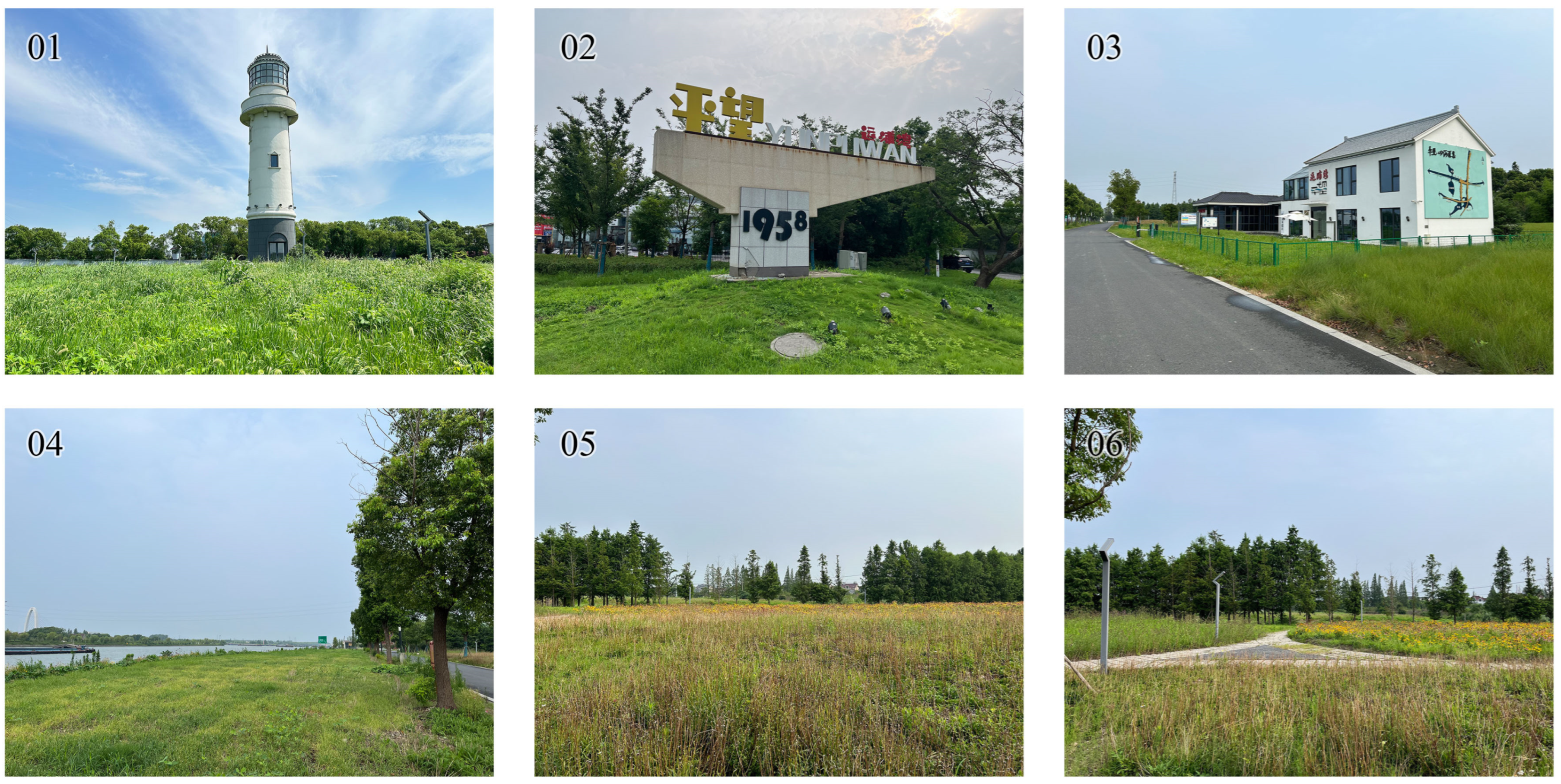

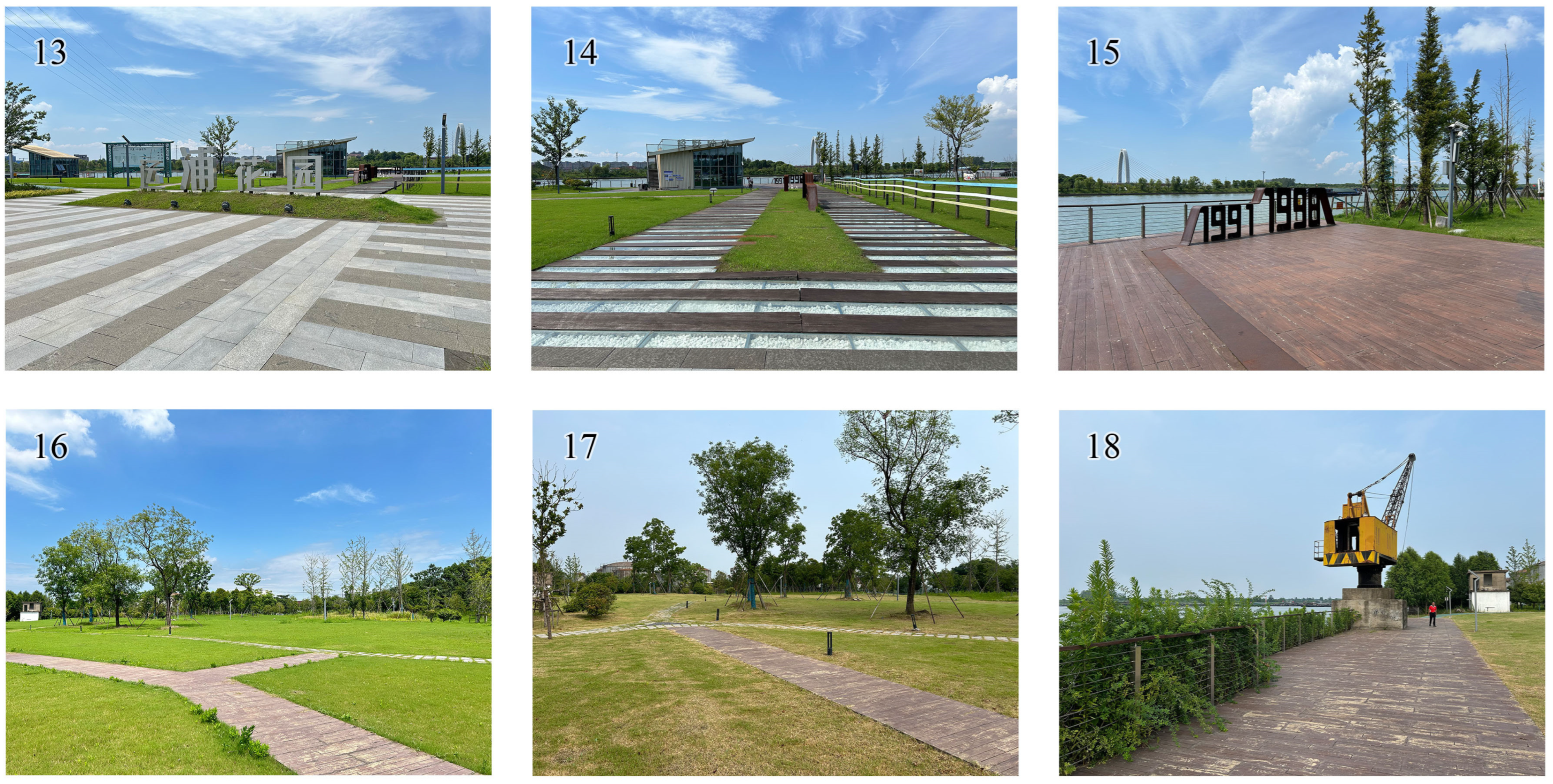

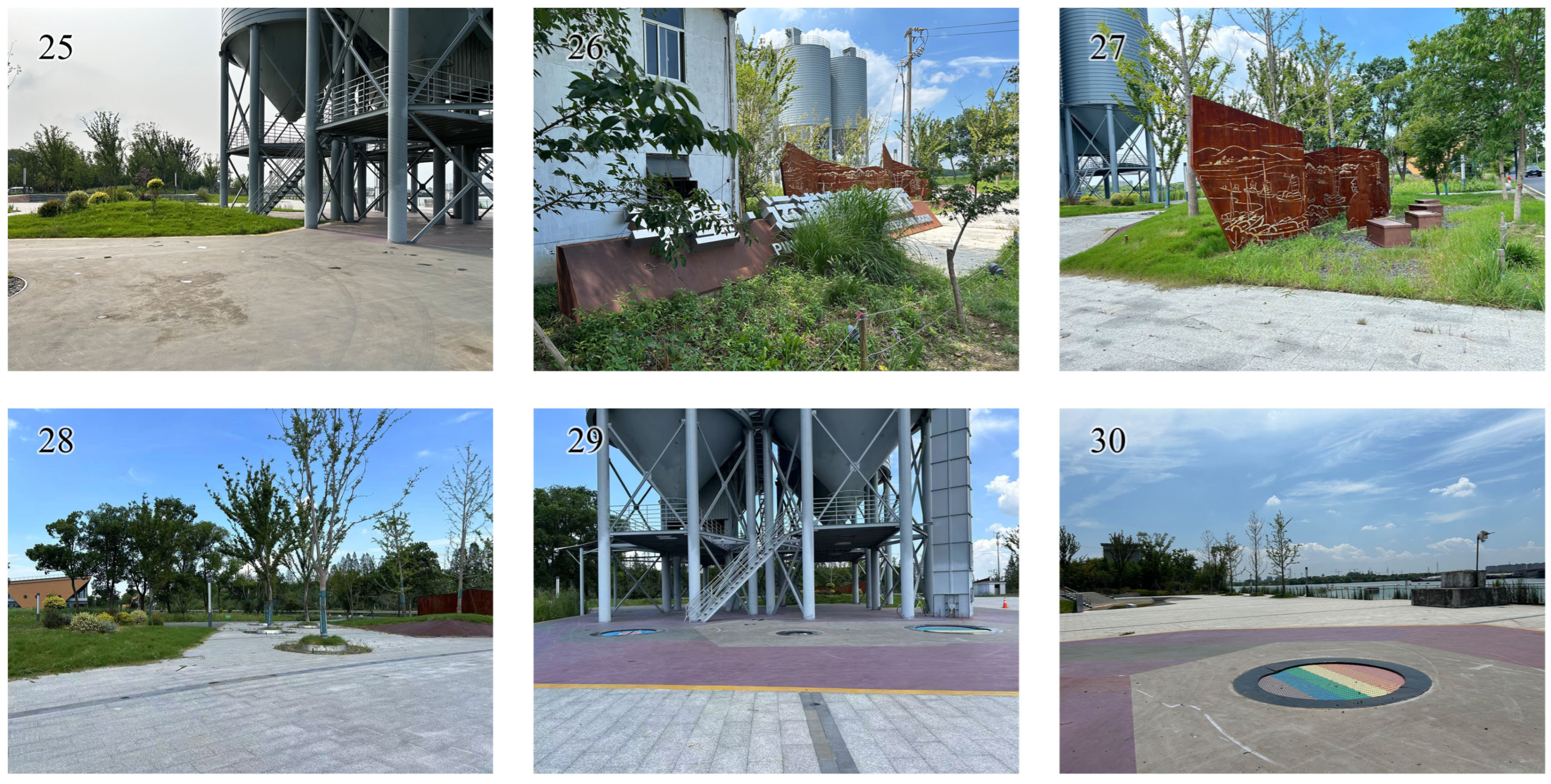
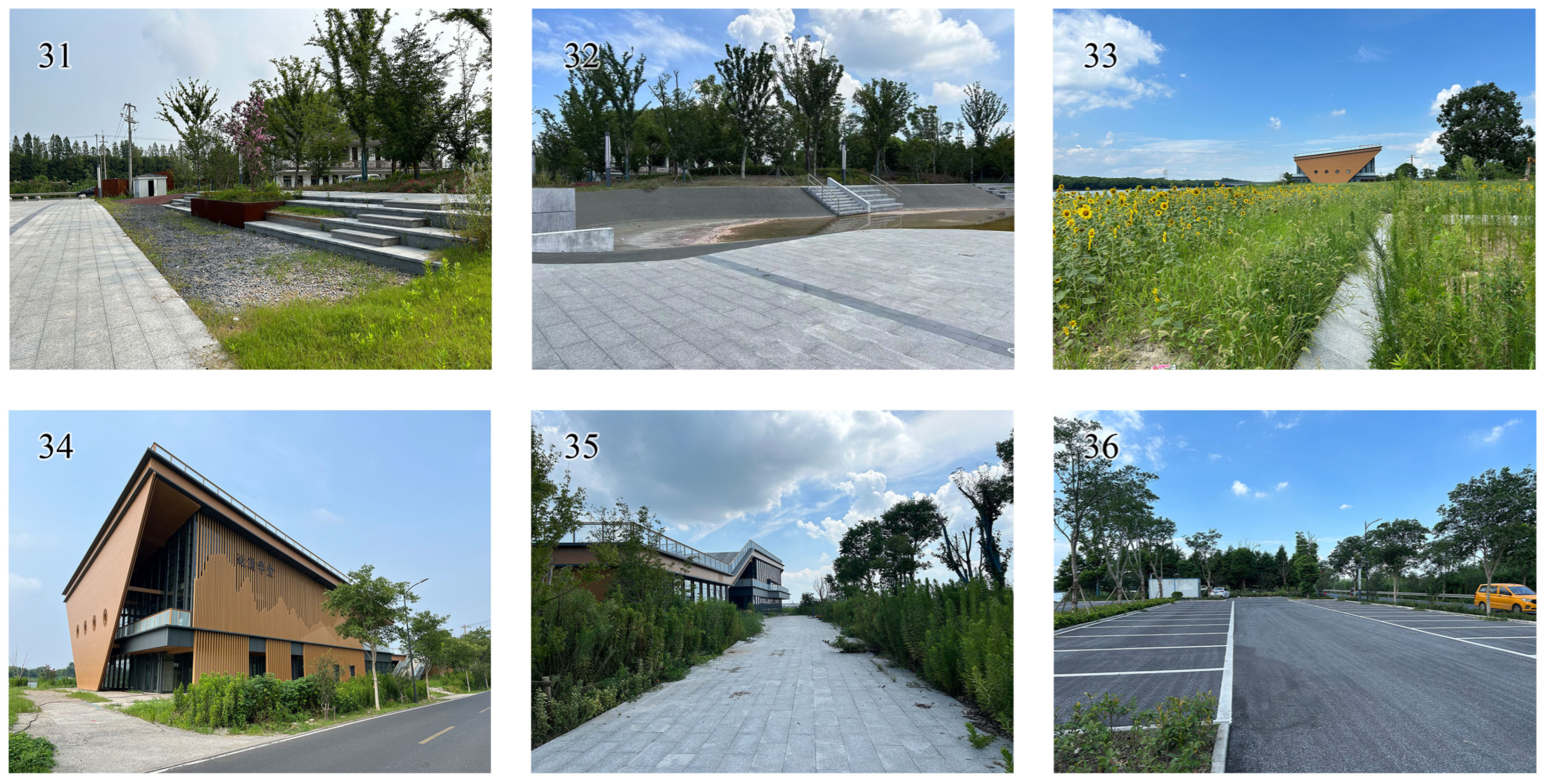
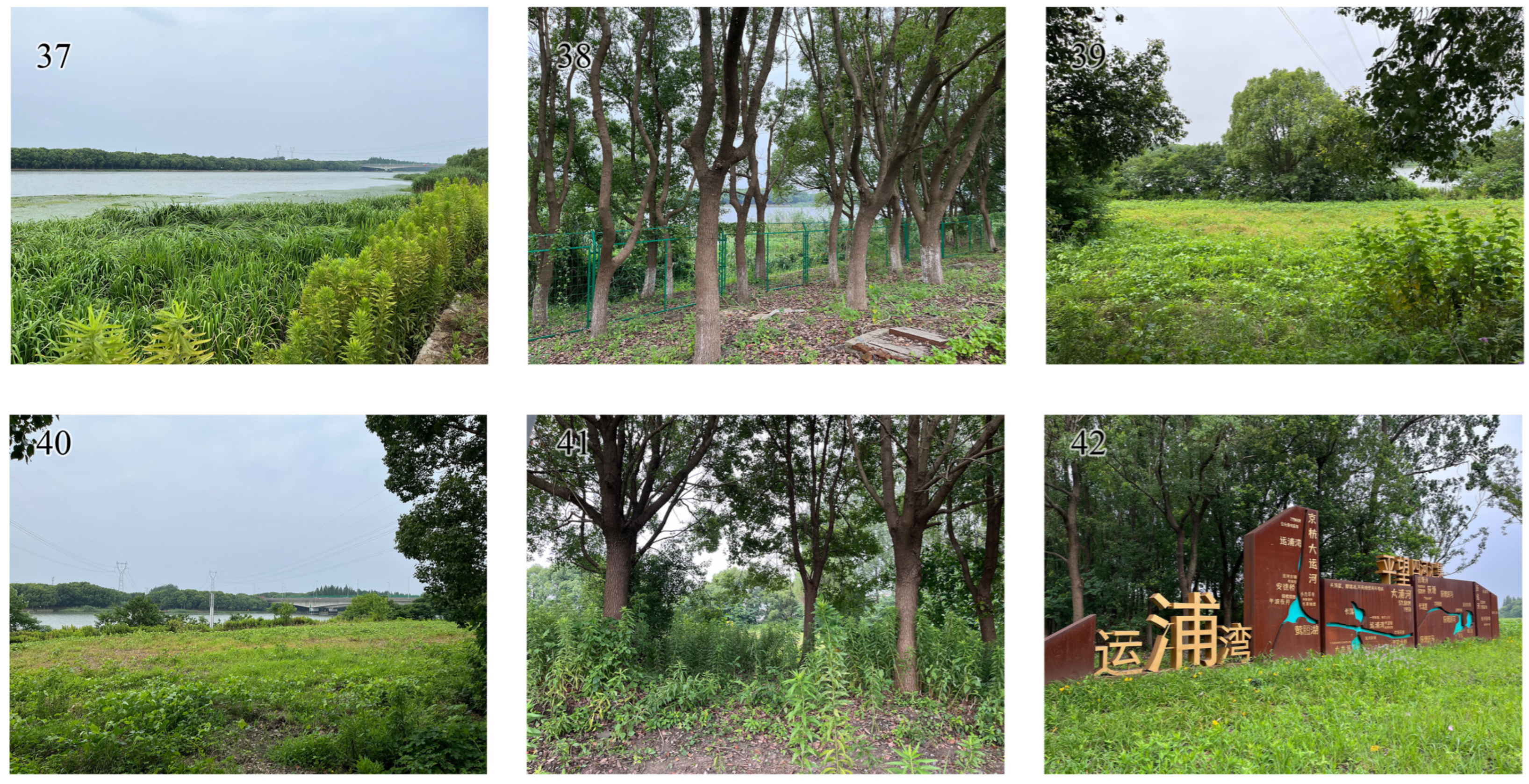


References
- Huang, C.; Wei, F.; Qiu, S.; Cao, X.; Chen, L.; Xu, J.; Gao, J.; Lin, Q. Interpreting Regenerated Post-Industrial Lands as Green Spaces: Comparing Public Perceptions of Post-Industrial Landscapes Using Human Factor Design Framework. Ecol. Indic. 2023, 157, 111282. [Google Scholar] [CrossRef]
- Ravaz, B.; Bombenger, P.-H.; Capezzali, M.; Meyer, T. Reviewing 20 Years of Redevelopment Trajectories of Industrial Sites Literature and Highlighting New Research Perspectives. Land Use Policy 2024, 146, 107326. [Google Scholar] [CrossRef]
- Sun, L.; Fan, X. Research Hotspots and Future Trends in Canal-Related Industrial Buildings. Sustainability 2024, 16, 5208. [Google Scholar] [CrossRef]
- Marsh, B. Living by the Symbolic River: Landscape Effects of Post-Industrial Water Narratives of the Susquehanna River. Land 2023, 12, 264. [Google Scholar] [CrossRef]
- Huang, C.; Wei, F.; Han, Q.; Xu, J.; Qiu, S.; Ban, X.; Huang, Y.; Huang, T. Visual and Emotional Interaction between People and Post-Industrial Riverscape Based on the Significance of “Original—New Placement. Ecol. Indic. 2024, 163, 112135. [Google Scholar] [CrossRef]
- Heesche, J.; Braae, E.M.; Jørgensen, G. Landscape-Based Transformation of Young Industrial Landscapes. Land 2022, 11, 908. [Google Scholar] [CrossRef]
- Liu, Z.; Fang, H.; Xu, S.; Wu, Y.; Wen, K.; Shen, Z.; Wang, H. Retain or Remove? Decision-Making of Rural Industrial Park Redevelopment in Nanhai District, China. Front. Environ. Sci. 2024, 12, 1347723. [Google Scholar] [CrossRef]
- Suzhou Municipal People’s Government. Advancing the “Three Optimizations and Three Safeguards” to Build Development Momentum: The Chairpersons’ Meeting of the Standing Committee of the Suzhou Municipal People’s Congress Received a Briefing. Available online: https://www.suzhou.gov.cn/szsrmzf/szyw/202108/66b299c3a58d4c77a6e7dccfce63ca2b.shtml (accessed on 13 August 2025).
- Ministry of Culture and Tourism. Notice by Seventeen Departments Including the Ministry of Culture and Tourism on Issuing the Guiding Opinions on Promoting the Sustainable Development of Rural Tourism. Available online: https://www.gov.cn/zhengce/zhengceku/2018-12/31/content_5433069.htm?utm_source=chatgpt.com (accessed on 13 August 2025).
- Xinhua News Agency. Opinions of the CPC Central Committee and the State Council on Implementing the Rural Revitalization Strategy. Available online: https://www.gov.cn/zhengce/2018-02/04/content_5263807.htm?utm_source=chatgpt.com (accessed on 13 August 2025).
- Yanan, L.; Ismail, M.A.; Aminuddin, A. How Has Rural Tourism Influenced the Sustainable Development of Traditional Villages? A Systematic Literature Review. Heliyon 2024, 10, e25627. [Google Scholar] [CrossRef] [PubMed]
- Shen, S.; Wang, H.; Quan, Q.; Xu, J. Rurality and Rural Tourism Development in China. Tour. Manag. Perspect. 2019, 30, 98–106. [Google Scholar] [CrossRef]
- Chen, P.; Zhang, M.; Wang, Y. Beyond Displacement: The Co-Existence of Newcomers and Local Residents in the Process of Rural Tourism Gentrification in China. J. Sustain. Tour. 2024, 32, 8–26. [Google Scholar] [CrossRef]
- Li, S.; Zhang, Y.; Long, H.; Xu, L. Understanding Rural Gentrification in China: Examining the Evolving Concept and Comparative Insights. J. Rural Stud. 2024, 108, 103301. [Google Scholar] [CrossRef]
- Yang, X.S.; Xu, H. Producing an Ideal Village: Imagined Rurality, Tourism and Rural Gentrification in China. J. Rural Stud. 2022, 96, 1–10. [Google Scholar] [CrossRef]
- Cheng, H.; Rui, Q.; Yu, K.; Li, X.; Liu, J. Exploring the Influencing Paths of Villagers’ Participation in the Creation of Micro-Landscapes: An Integrative Model of Theory of Planned Behavior and Norm Activation Theory. Front. Psychol. 2022, 13, 862109. [Google Scholar] [CrossRef]
- Martin, A.; Armijos, M.T.; Coolsaet, B.; Dawson, N.; AS Edwards, G.; Few, R.; Gross-Camp, N.; Rodriguez, I.; Schroeder, H.; GL Tebboth, M. Environmental Justice and Transformations to Sustainability. Environ. Sci. Policy Sustain. Dev. 2020, 62, 19–30. [Google Scholar] [CrossRef]
- Newell, P.; Srivastava, S.; Naess, L.O.; Torres Contreras, G.A.; Price, R. Toward Transformative Climate Justice: An Emerging Research Agenda. Wiley Interdiscip. Rev. Clim. Change 2021, 12, e733. [Google Scholar] [CrossRef]
- Brown, D.; Bégou, B.; Clement, F.; Coolsaet, B.; Darmet, L.; Gingembre, M.; Harmáčková, Z.V.; Martin, A.; Nohlová, B.; Barnaud, C. Conceptualising Rural Environmental Justice in Europe in an Age of Climate-Influenced Landscape Transformations. J. Rural Stud. 2024, 110, 103371. [Google Scholar] [CrossRef]
- Meenar, M.; Pánek, J.; Kitson, J.; York, A. Mapping the Emotional Landscapes of Parks in Post-Industrial Communities Enduring Environmental Injustices: Potential Implications for Biophilic City Planning. Cities 2025, 158, 105692. [Google Scholar] [CrossRef]
- Wang, Y.; Huang, Z.; Fan, A. Tourism and New Rurality: Gentrified Space versus Co-Created Place. Ann. Tour. Res. 2025, 113, 103979. [Google Scholar] [CrossRef]
- Smith, N.R. The End of the Village: Planning the Urbanization of Rural China; University of Minnesota Press: Minneapolis, MN, USA, 2021; Volume 33, ISBN 1-4529-6544-7. [Google Scholar]
- Pan, Z.; Chen, Y.; Huang, Y.; Zheng, L. The Vernacular Cultural Landscape in Traditional Villages: Global Hotspots, Emerging Trends, and a Case Study of China’s Qilu Cultural District. Front. Earth Sci. 2024, 12, 1511292. [Google Scholar] [CrossRef]
- Lo, K. Authoritarian Environmentalism, Just Transition, and the Tension between Environmental Protection and Social Justice in China’s Forestry Reform. For. Policy Econ. 2021, 131, 102574. [Google Scholar] [CrossRef]
- Au, A. Digitalization in China: Who’s Left behind? Inf. Commun. Soc. 2024, 27, 1247–1265. [Google Scholar] [CrossRef]
- Zhaxi, D. “Beautiful Countryside”: Green Development and the Making of Rural Urbanization in China. China Q. 2025, 263, 703–721. [Google Scholar] [CrossRef]
- Luo, Y.; Lin, Z. Spatial Accessibility Analysis and Optimization Simulation of Urban Riverfront Space Based on Space Syntax and POIs: A Case Study of Songxi County, China. Sustainability 2023, 15, 14929. [Google Scholar] [CrossRef]
- Brown, G.; Kyttä, M. Key Issues and Research Priorities for Public Participation GIS (PPGIS): A Synthesis Based on Empirical Research. Appl. Geogr. 2014, 46, 122–136. [Google Scholar] [CrossRef]
- Sherrouse, B.C.; Semmens, D.J.; Ancona, Z.H. Social Values for Ecosystem Services (SolVES): Open-Source Spatial Modeling of Cultural Services. Environ. Model. Softw. 2022, 148, 105259. [Google Scholar] [CrossRef]
- Li, W.; Song, Y.; Herr, C.M.; Stouffs, R. A Review of Big Data Applications in Studies of Urban Green Space. Urban For. Urban Green. 2024, 101, 128524. [Google Scholar] [CrossRef]
- Olteanu, A.; Castillo, C.; Diaz, F.; Kıcıman, E. Social Data: Biases, Methodological Pitfalls, and Ethical Boundaries. Front. Big Data 2019, 2, 13. [Google Scholar] [CrossRef]
- Yu, L.; Zhang, X.; He, F.; Liu, Y.; Wang, D. Participatory Rural Spatial Planning Based on a Virtual Globe-Based 3D PGIS. ISPRS Int. J. Geo-Inf. 2020, 9, 763. [Google Scholar] [CrossRef]
- Schlosberg, D. Reconceiving Environmental Justice: Global Movements and Political Theories. Environ. Politics 2004, 13, 517–540. [Google Scholar] [CrossRef]
- Gomez de la Rosa, C.; Vogt, K.A.; Aldana-Dominguez, J.; Scullion, J.J. Landscape Change and Its Environmental Justice Implications for Indigenous and Local Communities in Tubará, Colombia. Sustain. Sci. 2025, 1–15. [Google Scholar] [CrossRef]
- Walker, G. Globalizing Environmental Justice: The Geography and Politics of Frame Contextualization and Evolution. Glob. Soc. Policy 2009, 9, 355–382. [Google Scholar] [CrossRef]
- Sezavar, N.; Pazhouhanfar, M.; Van Dongen, R.P.; Grahn, P. The Importance of Designing the Spatial Distribution and Density of Vegetation in Urban Parks for Increased Experience of Safety. J. Clean. Prod. 2023, 403, 136768. [Google Scholar] [CrossRef]
- Massarella, K.; Sallu, S.M.; Ensor, J.E. Reproducing Injustice: Why Recognition Matters in Conservation Project Evaluation. Glob. Environ. Change 2020, 65, 102181. [Google Scholar] [CrossRef]
- Martin, A. Just Conservation: Biodiversity, Wellbeing and Sustainability; Routledge: London, UK, 2017; ISBN 1-315-76534-9. [Google Scholar]
- Daniel, T.C. Whither Scenic Beauty? Visual Landscape Quality Assessment in the 21st Century. Landsc. Urban Plan. 2001, 54, 267–281. [Google Scholar] [CrossRef]
- Ode, Å.; Tveit, M.S.; Fry, G. Capturing Landscape Visual Character Using Indicators: Touching Base with Landscape Aesthetic Theory. Landsc. Res. 2008, 33, 89–117. [Google Scholar] [CrossRef]
- Schirpke, U.; Mölk, F.; Feilhauer, E.; Tappeiner, U.; Tappeiner, G. How Suitable Are Discrete Choice Experiments Based on Landscape Indicators for Estimating Landscape Preferences? Landsc. Urban Plan. 2023, 237, 104813. [Google Scholar] [CrossRef]
- Häfner, K.; Zasada, I.; van Zanten, B.T.; Ungaro, F.; Koetse, M.; Piorr, A. Assessing Landscape Preferences: A Visual Choice Experiment in the Agricultural Region of Märkische Schweiz, Germany. Landsc. Res. 2018, 43, 846–861. [Google Scholar] [CrossRef]
- Harper, D. Talking about Pictures: A Case for Photo Elicitation. Vis. Stud. 2002, 17, 13–26. [Google Scholar] [CrossRef]
- Chambers, R. Participatory Rural Appraisal (PRA): Analysis of Experience. World Dev. 1994, 22, 1253–1268. [Google Scholar] [CrossRef]
- Mariel, P.; Hoyos, D.; Meyerhoff, J.; Czajkowski, M.; Dekker, T.; Glenk, K.; Jacobsen, J.B.; Liebe, U.; Olsen, S.B.; Sagebiel, J. Environmental Valuation with Discrete Choice Experiments: Guidance on Design, Implementation and Data Analysis; Springer Nature: Berlin/Heidelberg, Germany, 2021; ISBN 3-030-62669-5. [Google Scholar]
- Chen, L.-C.; Zhu, Y.; Papandreou, G.; Schroff, F.; Adam, H. Encoder-Decoder with Atrous Separable Convolution for Semantic Image Segmentation. In Proceedings of the European Conference on Computer Vision (ECCV), Munich, Germany, 8–14 September 2018; pp. 801–818. [Google Scholar]
- Li, X.; Li, L.; Wang, X.; Lin, Q.; Wu, D.; Dong, Y.; Han, S. Visual Quality Evaluation Model of an Urban River Landscape Based on Random Forest. Ecol. Indic. 2021, 133, 108381. [Google Scholar] [CrossRef]
- Rigolon, A. A Complex Landscape of Inequity in Access to Urban Parks: A Literature Review. Landsc. Urban Plan. 2016, 153, 160–169. [Google Scholar] [CrossRef]
- Davis, L.F.; Ramírez-Andreotta, M.D. Participatory Research for Environmental Justice: A Critical Interpretive Synthesis. Environ. Health Perspect. 2021, 129, 026001. [Google Scholar] [CrossRef]
- Wang, R.; Jiang, W.; Lu, T. Landscape Characteristics of University Campus in Relation to Aesthetic Quality and Recreational Preference. Urban For. Urban Green. 2021, 66, 127389. [Google Scholar] [CrossRef]
- Li, X.; Wang, X.; Jiang, X.; Han, J.; Wang, Z.; Wu, D.; Lin, Q.; Li, L.; Zhang, S.; Dong, Y. Prediction of Riverside Greenway Landscape Aesthetic Quality of Urban Canalized Rivers Using Environmental Modeling. J. Clean. Prod. 2022, 367, 133066. [Google Scholar] [CrossRef]
- Zhong, Y.; Zhang, M.; Xia, Y.; Hao, R.; Tan, L. Public Aesthetic and Recreational Preferences for Historical Irrigation Canals in Rural Areas: A Case Study in Li Canal-Gaoyou Irrigation District. Buildings 2024, 14, 1955. [Google Scholar] [CrossRef]
- Getis, A.; Ord, J.K. The Analysis of Spatial Association by Use of Distance Statistics. Geogr. Anal. 1992, 24, 189–206. [Google Scholar] [CrossRef]
- Krivoruchko, K. Empirical Bayesian Kriging. ArcUser Fall 2012, 6, 1145. [Google Scholar]
- Taksa, L. Interrogating the Unequal Gendered Legacy of Work in an Industrial Heritage Landscape. Ph.D. Thesis, Macquarie University Faculty of Business, Sydney, Australia, 2018. [Google Scholar]
- Hoyle, H.; Jorgensen, A.; Hitchmough, J.D. What Determines How We See Nature? Perceptions of Naturalness in Designed Urban Green Spaces. People Nat. 2019, 1, 167–180. [Google Scholar] [CrossRef]
- Hu, S.; Liu, J.; Que, J.; Su, X.; Li, B.; Quan, C. Perceptions of Urban Rewilding in a Park with Secondary Succession Vegetation Growth on Lake Silt: Landscape Preferences and Perceived Species Richness. Urban For. Urban Green. 2025, 104, 128648. [Google Scholar] [CrossRef]
- Rosenkrantz, L. Urban Rewilding and Public Health Considerations. 2023. Available online: https://ncceh.ca/resources/evidence-briefs/urban-rewilding-and-public-health-considerations (accessed on 20 September 2025).
- Shao, Z.; Tang, Y. Canal-Orientated Urban Waterfront Regeneration Based on the Concept of Everyday Heritage: A Case Study in Suzhou, China. Archit. MPS 2025, 30, 2. [Google Scholar] [CrossRef]
- Mehta, V. Evaluating Public Space. J. Urban Des. 2014, 19, 53–88. [Google Scholar] [CrossRef]
- Tilden, F. Interpreting Our Heritage; ReadHowYouWant.com: Sydney, Australia, 2009; ISBN 1-4429-9800-8. [Google Scholar]
- Harlov-Csortán, M. The Importance of Oral History in (Industrial) Heritagisation. BIOS Z. Biogr. Oral Hist. Leb. 2020, 31, 134–145. [Google Scholar] [CrossRef]
- Yan, J.; Huang, Y.; Tan, S.; Lang, W.; Chen, T. Jointly Creating Sustainable Rural Communities through Participatory Planning: A Case Study of Fengqing County, China. Land 2023, 12, 187. [Google Scholar] [CrossRef]
- Loures, L.; Panagopoulos, T.; Burley, J.B. Assessing User Preferences on Post-Industrial Redevelopment. Environ. Plan. B Plan. Des. 2015, 43, 871–892. [Google Scholar] [CrossRef]
- Manzo, L.C.; Perkins, D.D. Finding Common Ground: The Importance of Place Attachment to Community Participation and Planning. J. Plan. Lit. 2006, 20, 335–350. [Google Scholar] [CrossRef]
- Li, N.; Gu, D.; Li, Y.; Huang, X.; Chen, Q.; Li, X.; Lv, B. Exploring the Link Between Landscape Perception and Community Participation: Evidence from Gateway Communities in Giant Panda National Park, China. Land 2024, 13, 2216. [Google Scholar] [CrossRef]
- Nowacki, M. Heritage Interpretation and Sustainable Development: A Systematic Literature Review. Sustainability 2021, 13, 4383. [Google Scholar] [CrossRef]
- Weng, L.; Liang, Z.; Bao, J. The Effect of Tour Interpretation on Perceived Heritage Values: A Comparison of Tourists with and without Tour Guiding Interpretation at a Heritage Destination. J. Destin. Mark. Manag. 2020, 16, 100431. [Google Scholar] [CrossRef]
- Elderbrock, E.; Russel, K.; Ko, Y.; Budd, E.; Gonen, L.; Enright, C. Evaluating Urban Green Space Inequity to Promote Distributional Justice in Portland, Oregon. Land 2024, 13, 720. [Google Scholar] [CrossRef]
- Peng, L.; He, L.; Shen, M.; Zhao, M.; Armatas, C.A. Understanding Stakeholder Perceptions of Environmental Justice: A Study of Tourism in the Erhai Lake Basin, Yunnan Province, China. Ecol. Soc. 2023, 28, 1. [Google Scholar] [CrossRef]
- Wei, X.; Hu, Q. Development of Rural Tourism in China: The Tragedy of Anti-Commons. Front. Public Health 2022, 10, 939754. [Google Scholar] [CrossRef] [PubMed]
- Xie, L. Environmental Governance and Public Participation in Rural China. China Inf. 2016, 30, 188–208. [Google Scholar] [CrossRef]

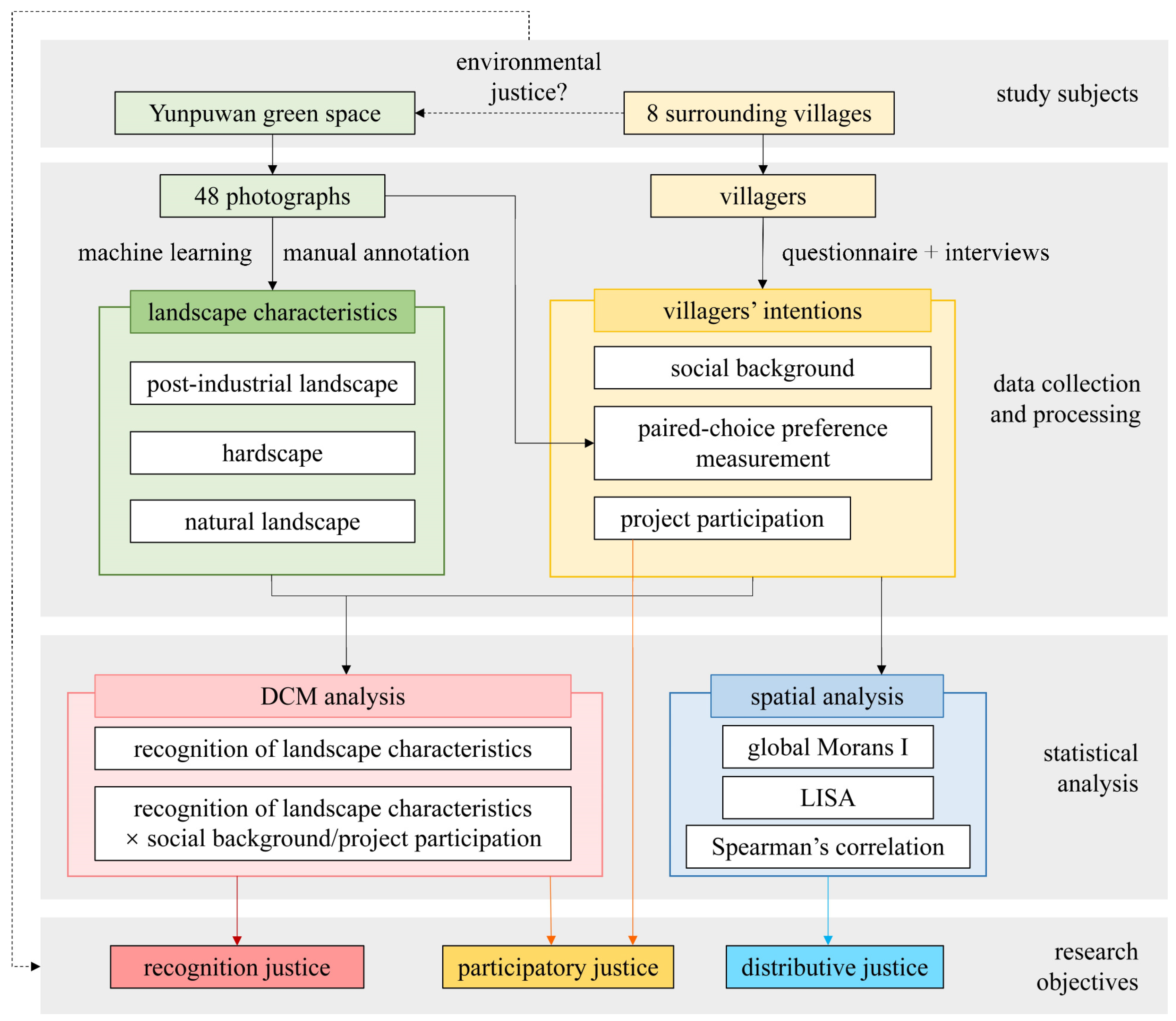

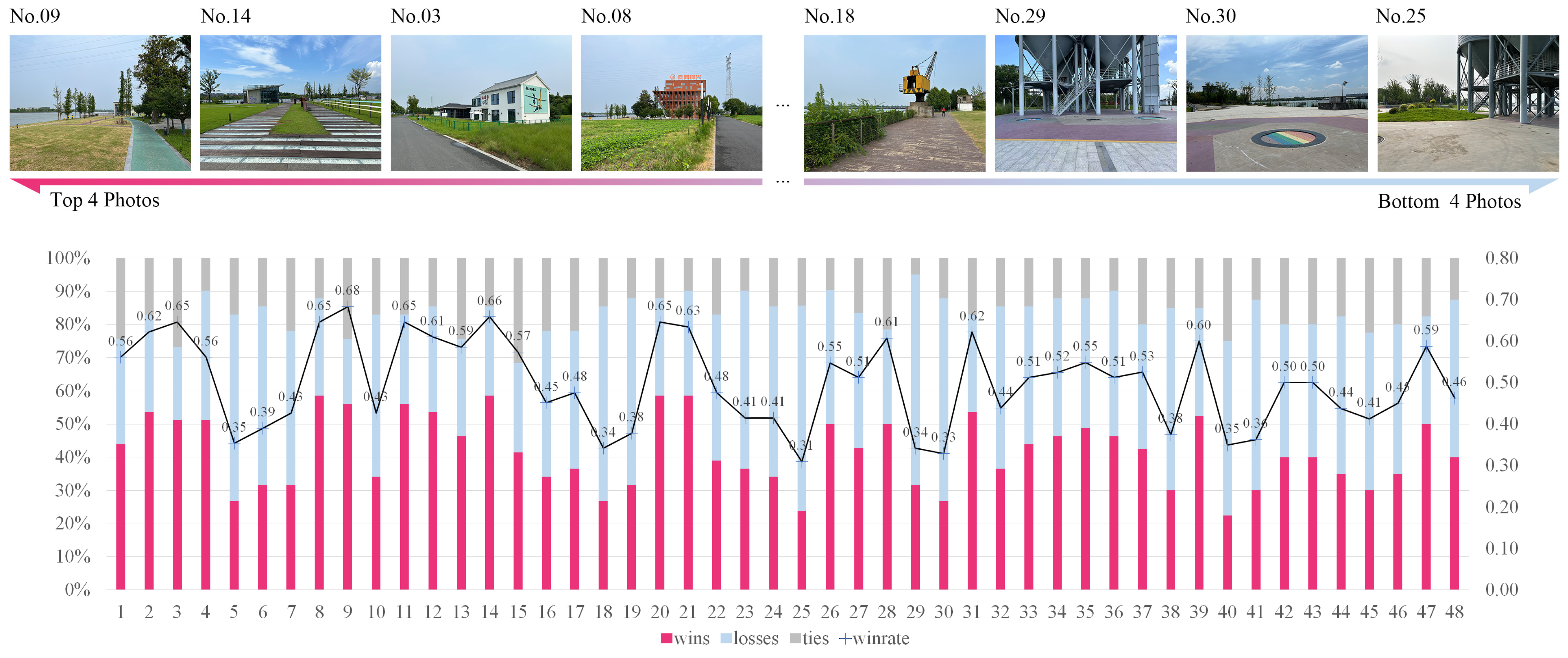
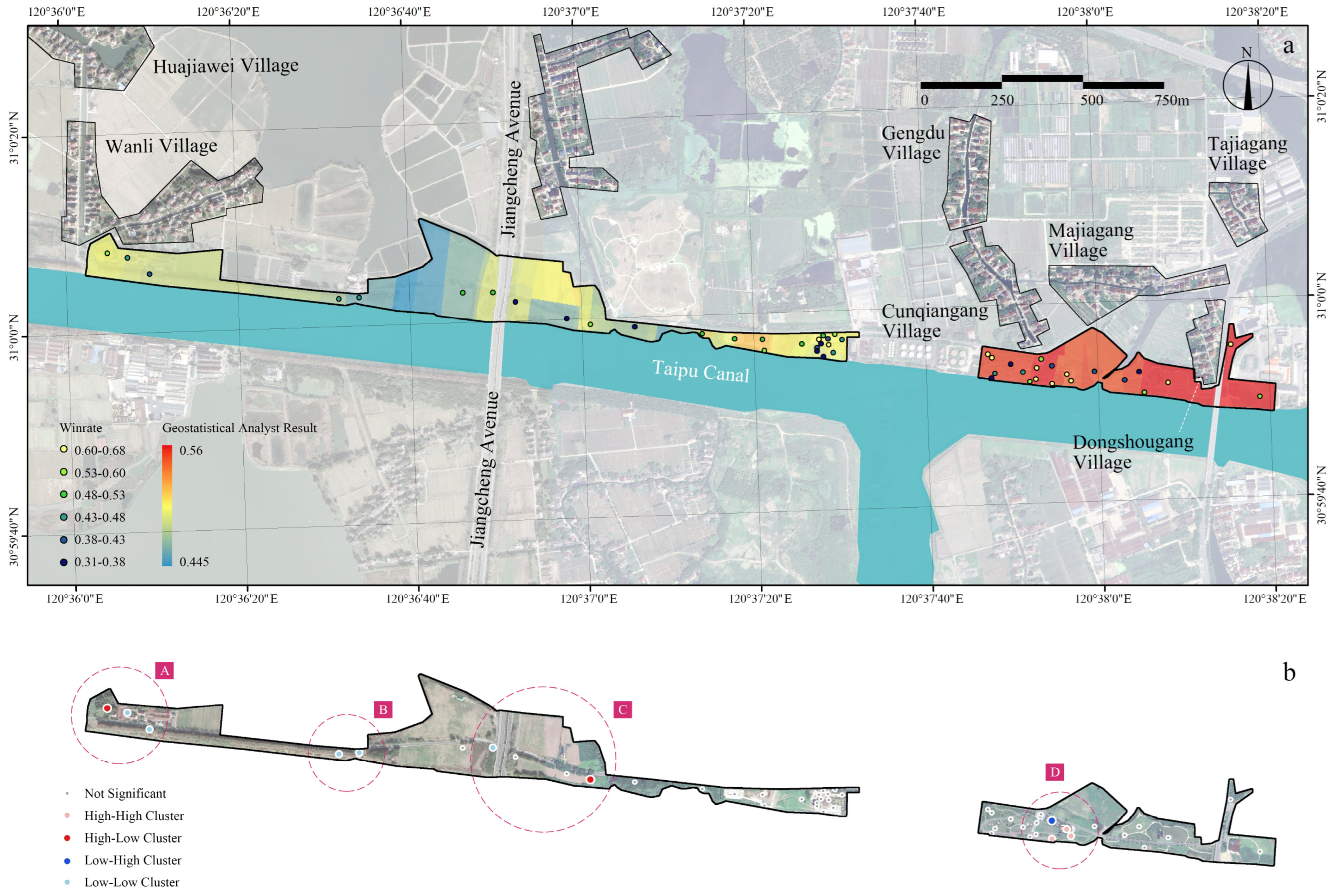
| Justice Type | Definition | Measurement | References |
|---|---|---|---|
| Recognition Justice | Respect for residents’ identities, cultures, and landscape experiences, including industrial-memory elements | Paired photo preference; landscape characteristics quantification; semi-structured interviews; discrete choice model | [33,34,35,36] |
| Participatory Justice | Residents’ involvement in planning, decision-making, and feedback | Semi-structured interviews; discrete choice model | [33,34,37] |
| Distributive Justice | Fair spatial distribution and accessibility of landscape benefits | Global Moran’s I, LISA, Spearman’s correlation | [33,34,38] |
| Landscape Type | Landscape Characteristics | Measurement | Notes |
|---|---|---|---|
| industrial heritage and landscape | industrial heritage (%) | percentage | industrial heritage retained or adapted from former factories |
| industrial-memory landscape (%) | percentage | including large on-site signage, industrial-memory installations, and special paving | |
| natural landscape | herbaceous (%) | percentage | including flowering herbs, lawns, aquatic plants, and climbers |
| shrub (%) | percentage | ||
| tree (%) | percentage | ||
| total vegetation (%) | percentage | sum of trees, shrubs, and herbaceous cover | |
| vegetation naturalness | manual scoring | 1 = horticulturally formal; 5 = wild | |
| water bodies (%) | percentage | includes rivers and ponds, but excludes temporary standing water | |
| waterfront access | manual coding | present (1) or absent (0); whether conditions allow activities or viewing at the water’s edge | |
| sky openness (%) | percentage | percentage of visible sky | |
| hardscape | pedestrian paths (%) | percentage | |
| plazas (%) | percentage | ||
| service buildings (%) | percentage | excluding off-site buildings and buildings that are not service-oriented | |
| vehicular infrastructure (%) | percentage | parking lots and carriageways | |
| total hardscape (%) | percentage | includes all types of paved grounds and facilities | |
| parking lots | manual coding | present (1) or absent (0) |
| Code | Item (Construct) * | Options (Coding) * |
|---|---|---|
| Q1 | gender (gender) | male (1); female (0) |
| Q2 | village where you live | — |
| Q3 | age group (age) | 60+ (6); 51–60 (5); 41–50 (4); 31–40 (3); 26–30 (2); 18–25 (1); under 18 (0) |
| Q4 | How many years have you lived in this village? (years) | — |
| Q5 | highest educational attainment (education) | graduate and above (4); bachelor’s degree (3); junior college/associate (2); high school/technical secondary (1); junior high and below (0) |
| Q6–Q16 | paired-choice tasks: Which option do you recognize more, consider more suitable for local villagers to use, and prefer more? | example: |
| Q17 | Before this survey, did you know about the Yunpuwan green space project? (awareness) | yes (1); no (0) |
| Q18 | Have you ever used the Yunpuwan green space? (use) | often (2); occasionally (1); never (0) |
| Q19 | Have you ever worked at the factory here? (work history) | yes (1); no (0) |
| Q20 | During the implementation of this project, did you offer any suggestions? how were they acted upon? | open-ended response |
| Q21 | Do you currently have any suggestions for this project? | open-ended response |
| Q22 | From your perspective as a villager, do you recognize this project overall? (Overall recognition) | Yes, this project meets our needs (2) Neutral, this project meets some of our needs (1) No, this project is not favorable to us (0) |
| Item | Option | Frequency | % |
|---|---|---|---|
| gender | female | 48 | 48.98 |
| male | 50 | 51.02 | |
| age | under 18 | 3 | 3.06 |
| 18–25 | 5 | 5.10 | |
| 26–30 | 2 | 2.04 | |
| 31–40 | 8 | 8.16 | |
| 41–50 | 9 | 9.18 | |
| 51–60 | 8 | 8.16 | |
| 60+ | 63 | 64.29 | |
| years lived in this village | 1–20 | 21 | 0.21 |
| 20–40 | 17 | 0.17 | |
| 40–60 | 17 | 0.17 | |
| 60–80 | 39 | 0.40 | |
| 80+ | 4 | 0.04 | |
| education | junior high and below | 80 | 81.63 |
| high school/technical secondary | 8 | 8.16 | |
| junior college/associate | 3 | 3.06 | |
| bachelor’s degree | 4 | 4.08 | |
| graduate and above | 3 | 3.06 |
| Variable | β | Clustered Std. Error | z | p | 95% CI Lower | 95% CI Upper |
|---|---|---|---|---|---|---|
| vegetation naturalness | −0.1761 | 0.0612 | −2.8790 | 0.0040 | −0.2959 | −0.0562 |
| plazas | −0.3613 | 0.1284 | −2.8139 | 0.0049 | −0.6130 | −0.1096 |
| industrial heritage | −0.1935 | 0.0732 | −2.6426 | 0.0082 | −0.3371 | −0.0500 |
| pedestrian paths | −0.1979 | 0.0913 | −2.1669 | 0.0302 | −0.3768 | −0.0189 |
| hardscape | 0.9415 | 0.4705 | 2.0012 | 0.0454 | 0.0194 | 1.8637 |
| Variable | γ | Clustered Std. Err. | z | p | 95% CI (Low) | 95% CI (High) |
|---|---|---|---|---|---|---|
| industrial-memory landscape × gender | 0.4553 | 0.1930 | 2.3594 | 0.0183 | 0.0771 | 0.8336 |
| industrial heritage × work history | 0.2383 | 0.1022 | 2.3307 | 0.0198 | 0.0379 | 0.4386 |
| water bodies (%) × years of residence | 0.4203 | 0.1911 | 2.1987 | 0.0279 | 0.0456 | 0.7949 |
| total hardscape (%) × years of residence | 3.3723 | 1.5996 | 2.1082 | 0.0350 | 0.2371 | 6.5074 |
| waterfront access × project awareness | 0.3108 | 0.1485 | 2.0920 | 0.0364 | 0.0196 | 0.6019 |
| sky openness (%) × years of residence | 2.3943 | 1.2178 | 1.9661 | 0.0493 | 0.0075 | 4.7812 |
| Category | Specific Comment | Respondent ID |
|---|---|---|
| landscape design optimization | too much grass | 04 |
| unsafe along the riverbank | 19 | |
| not interesting | 73 | |
| nothing there | 94 | |
| removal of industrial artifacts; feels mismatched | 96 | |
| add more greenery/planting | 98 | |
| amenity provision | add more green amenities and some exercise facilities | 09 |
| lack of public toilets | 14 | |
| need a supermarket | 29 | |
| need outdoor fitness equipment | 32 | |
| too far away | 49 | |
| access road is too narrow; should be widened and have higher greening rate | 78 | |
| local economy & livelihoods | low footfall, poor publicity, lack of commercial services | 28 |
| suggest introducing folk-culture activities | 66 | |
| elderly residents have lost job opportunities; situation is chaotic | 72 | |
| factory buildings demolished, no job opportunities | 89 | |
| project implementation | sufficient publicity/outreach | 30 |
| merely turned into a park | 46 | |
| accelerate progress | 56 |
Disclaimer/Publisher’s Note: The statements, opinions and data contained in all publications are solely those of the individual author(s) and contributor(s) and not of MDPI and/or the editor(s). MDPI and/or the editor(s) disclaim responsibility for any injury to people or property resulting from any ideas, methods, instructions or products referred to in the content. |
© 2025 by the authors. Licensee MDPI, Basel, Switzerland. This article is an open access article distributed under the terms and conditions of the Creative Commons Attribution (CC BY) license (https://creativecommons.org/licenses/by/4.0/).
Share and Cite
Guo, M.; Zhong, Y.; Tan, L.; Li, X.; Wang, J.; Jin, H. Environmental Justice in the Green Transition of Rural Post-Industrial Waterfronts: A Villagers’ Perspective—A Case Study of the Waterfront Area in Jiangsu Province, China. Land 2025, 14, 2204. https://doi.org/10.3390/land14112204
Guo M, Zhong Y, Tan L, Li X, Wang J, Jin H. Environmental Justice in the Green Transition of Rural Post-Industrial Waterfronts: A Villagers’ Perspective—A Case Study of the Waterfront Area in Jiangsu Province, China. Land. 2025; 14(11):2204. https://doi.org/10.3390/land14112204
Chicago/Turabian StyleGuo, Meng, Yujia Zhong, Li Tan, Xin Li, Jiayu Wang, and Haitao Jin. 2025. "Environmental Justice in the Green Transition of Rural Post-Industrial Waterfronts: A Villagers’ Perspective—A Case Study of the Waterfront Area in Jiangsu Province, China" Land 14, no. 11: 2204. https://doi.org/10.3390/land14112204
APA StyleGuo, M., Zhong, Y., Tan, L., Li, X., Wang, J., & Jin, H. (2025). Environmental Justice in the Green Transition of Rural Post-Industrial Waterfronts: A Villagers’ Perspective—A Case Study of the Waterfront Area in Jiangsu Province, China. Land, 14(11), 2204. https://doi.org/10.3390/land14112204






